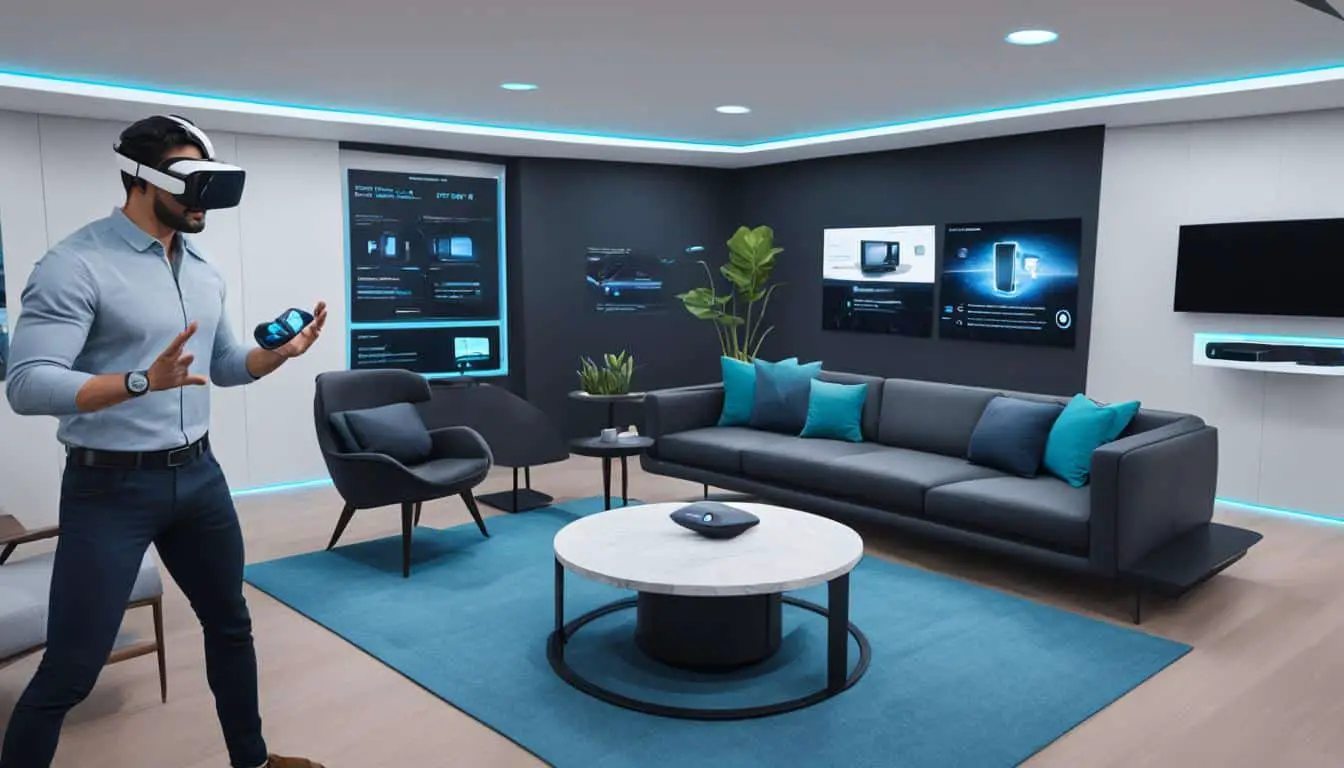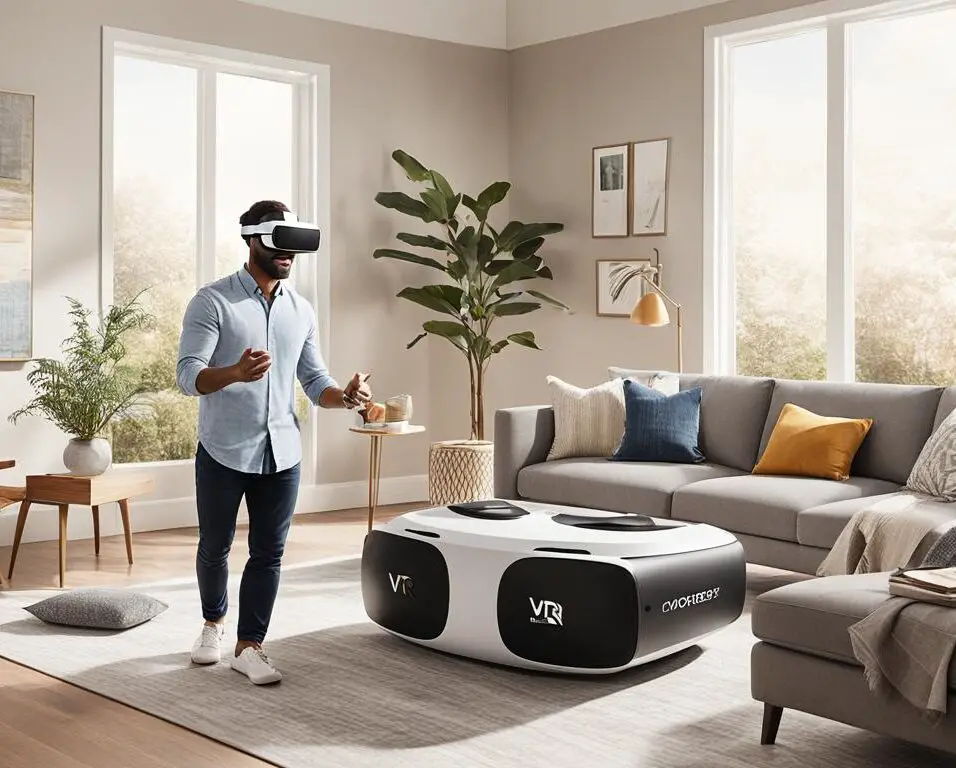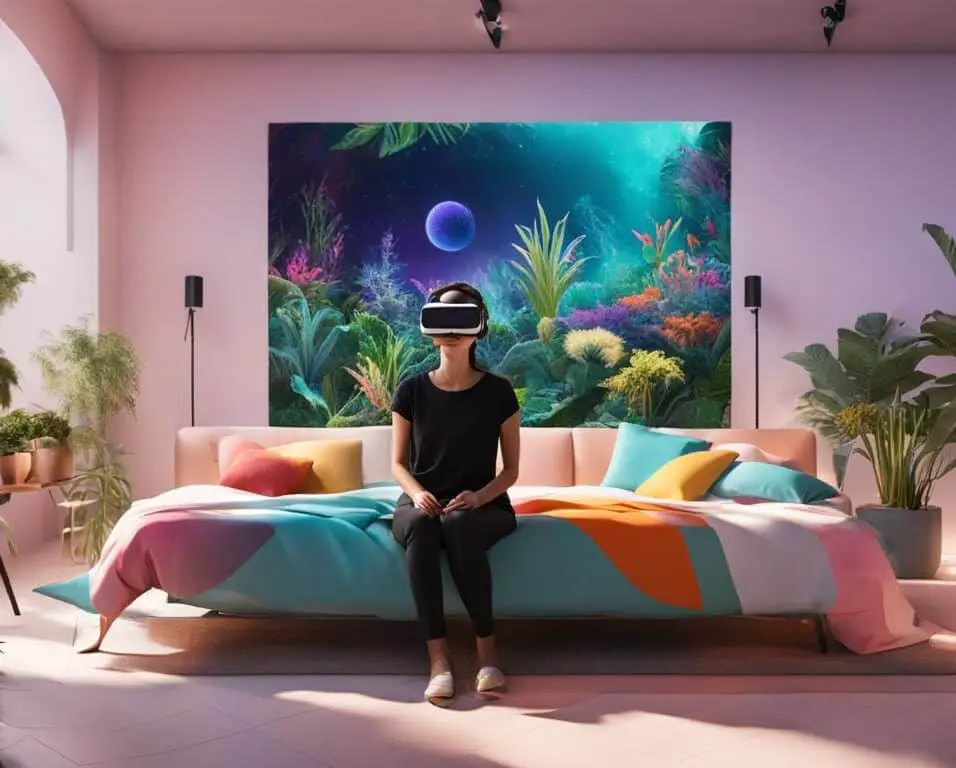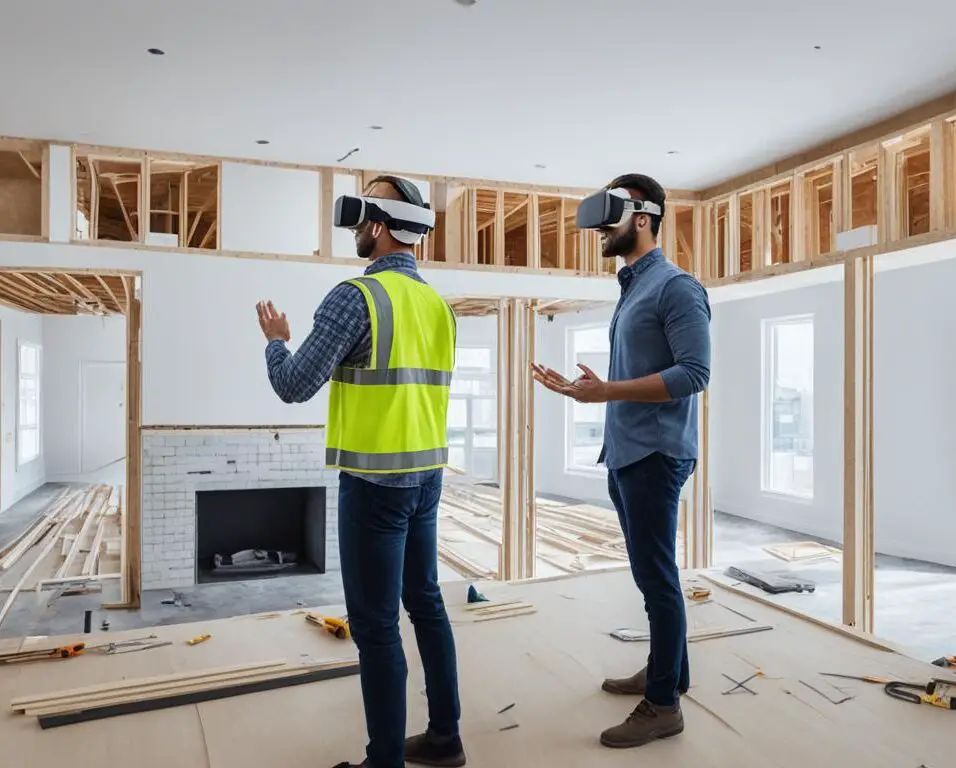Safe and Secure: Integrating VR in Home Security Planning
As a homeowner, one of my top priorities is ensuring the safety and security of my property and loved ones. That’s why I’m always on the lookout for innovative approaches to home security planning. Recently, I came across a groundbreaking solution that combines virtual reality (VR) technology with traditional security measures– VR integration in home security planning.
With VR integration, I can now visualize and simulate potential threats, test security measures, and make informed decisions to enhance the safety and security of my home. This technology has revolutionized the way I approach home security, offering a comprehensive and immersive solution that goes beyond traditional methods.
Key Takeaways:
- VR integration in home security planning enables homeowners to visualize and simulate potential threats.
- By testing security measures in a virtual environment, homeowners can identify vulnerabilities and optimize their security system.
- VR integration provides an opportunity to train and educate household members on emergency procedures and the use of security equipment.
- Implementing VR integration involves investing in VR equipment, creating a virtual representation of your property, and simulating security scenarios.
- Future developments in VR integration for home security include the integration of artificial intelligence and advancements in hardware technology.
The Benefits of VR Integration in Home Security Planning
Integrating virtual reality (VR) technology into home security planning offers numerous benefits for homeowners. By harnessing the power of VR, you can enhance the effectiveness of your security system and ensure the safety of your home and loved ones. Let’s explore the advantages of incorporating VR integration into your home security planning:
- Visualizing and Experiencing Realistic Security Threats: VR allows you to step into a realistic virtual environment where you can visualize and experience potential security threats firsthand. By immersing yourself in these virtual scenarios, you can identify vulnerabilities and gain valuable insights to optimize your security measures.
- Testing Security Measures and Their Effectiveness: With VR integration, you can simulate different security scenarios and evaluate the effectiveness of various security measures. This enables you to make informed decisions about the best security solutions for your home, ensuring comprehensive protection against a range of potential threats.
- Training and Educating Household Members: VR provides an excellent opportunity to train and educate household members on emergency procedures and the proper use of security equipment. Through interactive VR simulations, you can familiarize everyone with protocols and empower them to respond effectively in critical situations.
By harnessing these benefits, homeowners can create a robust and proactive approach to home security planning.
“Integrating VR technology into home security planning allows homeowners to visualize potential security threats, test security measures, and train household members effectively.”
Visualizing and Experiencing Realistic Security Threats
The ability to visualize and experience security threats in a realistic virtual environment is a game-changer for home security planning. By immersing yourself in virtual scenarios, you can gain a comprehensive understanding of potential vulnerabilities in your home’s security system. This unique perspective empowers you to take proactive steps to address these weaknesses, ensuring a safer and more secure living environment for you and your family.
Testing Security Measures and Their Effectiveness
VR integration allows homeowners to test security measures and their effectiveness through simulated scenarios. This invaluable testing process enables you to evaluate different security solutions and assess their performance in various situations. By identifying any shortcomings or gaps in your security system, you can make informed decisions to optimize your defenses and enhance the overall safety of your home.
Training and Educating Household Members
In addition to assessing security measures, VR integration offers an excellent platform for training and educating household members on emergency procedures. Through interactive VR simulations, you can ensure that everyone in your household understands the appropriate response protocols in the event of a security breach or emergency. This comprehensive training enhances overall preparedness, promoting a collective sense of safety and security within your home.
By harnessing the benefits of VR integration in home security planning, you can elevate your security measures to new heights. The ability to visualize and experience realistic threats, test security measures, and train household members effectively creates a comprehensive approach to safeguarding your home and loved ones.
| Benefits of VR Integration in Home Security Planning |
|---|
| Visualize and experience potential security threats |
| Test security measures and their effectiveness |
| Train and educate household members on emergency procedures |
How VR Integration Works in Home Security Planning
VR integration plays a significant role in home security planning by using virtual reality technology to create a simulated environment that replicates your home. Through the utilization of special VR equipment such as headsets and motion sensors, homeowners can immerse themselves in a virtual representation of their property and effectively assess security risks. This innovative technology allows for interactive simulations, empowering you to test different security scenarios and optimize the effectiveness of your security system.
By wearing VR headsets, you can step into a virtual environment that mirrors your home, providing a firsthand perspective of potential security vulnerabilities. The motion sensors ensure that your movements are accurately tracked, enabling you to navigate and interact seamlessly with the virtual space. You can explore every corner of your home, surveying it from various angles and identifying any areas that may require additional security measures.
Furthermore, VR integration allows for the simulation of different security scenarios, enabling you to test the resilience of your security system. By creating virtual intruder scenarios or simulated emergency situations, you can evaluate the effectiveness of your current security measures and identify any potential gaps in your home security plan.
“VR integration in home security planning provides a high level of realism and interactivity, allowing homeowners to gain valuable insights into their home’s vulnerability and make informed decisions to enhance security.”
During the VR simulation, you can experiment with various security devices, such as locks, cameras, and motion sensors, to assess their effectiveness in deterring or preventing potential threats. By engaging in these simulations, you can make informed decisions regarding the placement and types of security equipment that best suit your home security needs.
Furthermore, VR integration can also serve as an educational tool, allowing household members to familiarize themselves with emergency procedures and the proper use of security equipment. Through immersive training scenarios, individuals can learn how to respond effectively to different security threats, ensuring their safety in potential real-life situations.
To summarize, VR integration in home security planning provides a realistic and interactive approach to assess security risks and test security measures. By replicating your home in a virtual environment, you gain valuable insights into potential vulnerabilities and can optimize your security system accordingly. This technology fosters informed decision-making and empowers you to create a safer and more secure living space.

| Benefits of VR Integration in Home Security Planning |
|---|
| Allows for visualization and assessment of security risks in a realistic simulated environment. |
| Enables testing of different security scenarios to optimize the effectiveness of your security system. |
| Provides an opportunity to train and educate household members on emergency procedures and the use of security equipment. |
| Allows for informed decision-making regarding the placement and types of security devices. |
| Offers a proactive approach to enhance the safety and security of your home. |
Implementing VR Integration in Home Security Planning
Implementing VR integration in home security planning can be an exciting and effective way to enhance the safety and security of your home. By combining virtual reality (VR) technology with traditional security measures, you can create a comprehensive and immersive security system. Here are the steps to follow:
- Invest in the necessary VR equipment and software: To get started, you’ll need VR headsets, sensors, and compatible security simulation software that allows you to simulate potential security scenarios.
- Map out your property and create a virtual representation: To accurately simulate your property, photograph or scan each room and use the VR technology to create a 3D model. This will allow you to navigate through a virtual representation of your home and assess security risks effectively.
- Simulate security scenarios and test different measures: With your virtual representation in place, you can now simulate various security scenarios and test different security measures to optimize the effectiveness of your security system. This will help you identify vulnerabilities and make adjustments based on the insights gained from the VR experience.
By incorporating VR integration into your home security planning, you can proactively identify and address potential security threats. The immersive and interactive nature of VR technology allows for a more realistic and comprehensive evaluation of your home’s security measures. It provides an opportunity to refine your security system and ensure the safety and well-being of your loved ones.
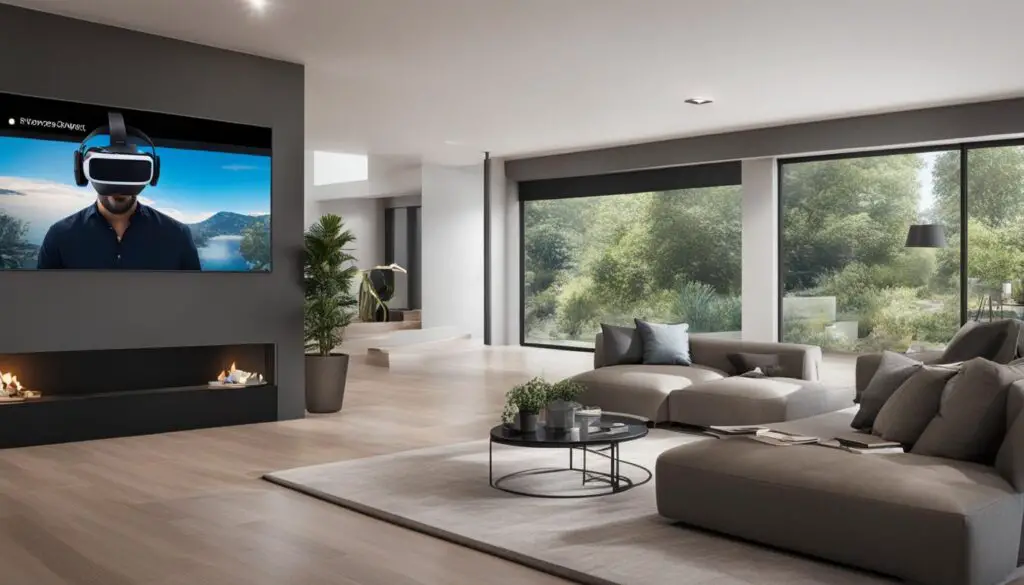
Benefits of Implementing VR Integration
“Implementing VR integration in home security planning can enhance the overall effectiveness and efficiency of your security system.”
Integrating VR technology into home security planning offers a range of benefits. By visualizing and experiencing potential security threats in a realistic virtual environment, you can identify vulnerabilities that may have been overlooked with traditional planning methods. This allows for better optimization of your security measures to ensure maximum protection for your home.
Additionally, VR integration allows for the testing of various security measures and their effectiveness in different scenarios. You can simulate break-ins, fires, or other emergencies to see how well your system responds and make necessary adjustments. Furthermore, VR technology provides an opportunity to train household members on emergency procedures and the use of security equipment, ensuring preparedness in critical situations.
Implementing VR integration in home security planning empowers you to take a proactive approach to home protection. By leveraging the immersive and interactive nature of VR technology, you can enhance the safety and security of your home and provide peace of mind for you and your family.
Comparison Table: Traditional Planning vs. VR Integration
| Traditional Planning | VR Integration |
|---|---|
| Relies on theoretical assessments of security risks | Provides realistic simulations of potential threats |
| Limited ability to test and adjust security measures | Allows for interactive testing and optimization of measures |
| May overlook vulnerabilities or blind spots | Offers a comprehensive evaluation of security system effectiveness |
| Minimal opportunity for training and preparedness | Enables realistic training scenarios and emergency procedure practice |
| Less proactive and responsive to evolving threats | Empowers proactive identification and mitigation of risks |
Future Developments in VR Integration for Home Security
The field of VR integration in home security planning is constantly evolving, paving the way for exciting future developments. One potential advancement is the integration of artificial intelligence (AI) with VR technology, introducing a more dynamic and responsive approach to security simulations.
By combining AI algorithms with VR, homeowners will benefit from enhanced security measures that can actively adapt to changing threats and scenarios. AI integration will enable more realistic and intelligent virtual simulations, providing homeowners with a comprehensive understanding of potential security risks.
Furthermore, advancements in VR hardware will significantly enhance the overall VR experience in home security planning. The continuous improvement of graphics technology will produce more realistic virtual environments, increasing the fidelity of security simulations.
Immersive haptic feedback is another area of VR hardware development that holds promise for home security integration. Through realistic tactile sensations, homeowners will have a more engaging and immersive VR experience, enhancing their ability to proactively plan and optimize their security measures.
The integration of artificial intelligence and the continuous improvement of VR hardware will not only revolutionize home security planning but also pave the way for more comprehensive and effective security systems.
As these future developments unfold, homeowners can expect VR integration to become an increasingly powerful tool in achieving optimal home security. By harnessing the potential of AI and continuously advancing VR hardware, the ability to simulate and address potential security threats will be greatly improved.
| Future Developments | Benefits |
|---|---|
| Integration of AI with VR | Dynamic and responsive security simulations |
| Advancements in VR hardware | More realistic graphics and immersive haptic feedback |
These future developments in VR integration for home security will empower homeowners to proactively protect their properties and loved ones. By leveraging advanced technologies and the immersive nature of VR, individuals can anticipate greater control over their security systems and make more informed decisions to ensure the safety and peace of mind that comes with a well-planned and optimized home security setup.
The Future of Home Security Planning with VR Integration
As technology continues to advance, the future of home security planning holds exciting possibilities with the integration of virtual reality (VR). With VR integration, homeowners can take their security measures to the next level, empowering them to make more informed decisions to safeguard their homes and loved ones.
Immersive Simulations for Enhanced Security
VR integration offers the ability to create interactive and realistic simulations that provide homeowners with a deeper understanding of potential security risks. By stepping into a virtual environment, individuals can experience simulated threats and vulnerabilities, allowing them to identify areas that require additional security measures or improvements.
With the detailed insights gained from these immersive simulations, homeowners can optimize their security plans and implement targeted solutions to address specific risks. From identifying blind spots in surveillance camera placements to evaluating the effectiveness of alarm systems, VR integration allows for precise home security planning tailored to individual needs and preferences.
Informed Decision-Making
VR integration also enables more informed decision-making regarding home security. By experiencing potential security scenarios in a virtual setting, homeowners can assess the performance of their current security measures and explore alternative options. This firsthand perspective provides invaluable information that can guide the selection and implementation of the most effective security solutions.
Furthermore, VR integration allows homeowners to visualize the impact of different security upgrades or modifications before making any physical changes to their properties. This not only saves time and resources but also enables a more strategic approach to home security planning.
Collaborative Security Planning
VR integration can facilitate collaborative security planning among household members. By immersing themselves in the virtual environment, family members can participate in security simulations together, enhancing their understanding of safety protocols and emergency procedures.
This collaborative approach fosters better communication and coordination during potential security incidents, ensuring that everyone knows their roles and responsibilities. Whether it’s responding to a simulated break-in or a natural disaster scenario, household members can practice and refine their responses in a safe and controlled environment.
Comparison of Home Security Planning Methods
| Methods | Advantages | Disadvantages |
|---|---|---|
| Traditional Methods |
|
|
| Virtual Reality Integration |
|
|
The Road Ahead
The future of home security planning with VR integration looks promising. Continued advancements in VR technology will likely result in even more realistic and immersive simulations, providing homeowners with an unparalleled understanding of their home’s security needs.
Moreover, the integration of AI with VR technology holds the potential for dynamic and responsive security simulations. AI algorithms can analyze real-time data and adapt the virtual scenarios to reflect current risks and trends, creating a more adaptive and future-proof home security planning experience.
With the continued evolution of VR integration, homeowners can look forward to a future where their homes are equipped with state-of-the-art security systems that have been meticulously planned and optimized in a virtual environment.
VR integration is revolutionizing the way we approach home security planning, and its future applications are full of promise. By embracing this cutting-edge technology, homeowners can proactively create safer and more secure living environments for themselves and their families.
Conclusion
VR integration in home security planning offers a cutting-edge approach to safeguarding your home. By utilizing VR technology, homeowners can visualize and simulate potential security threats, test security measures, and make informed decisions to enhance the safety and security of their homes.
As technology continues to advance, the future of home security planning with VR integration looks promising. With the potential for even more advanced simulations and enhancements to the overall home security experience, VR integration will undoubtedly play an even more significant role in creating safer homes.
Embracing VR integration in home security planning is a proactive step towards ensuring the safety and security of your home and loved ones. By harnessing the power of VR, homeowners can gain a deeper understanding of their security needs and optimize their security systems accordingly.
As the world becomes more interconnected, it is crucial to stay ahead of potential security risks. VR integration provides a unique and immersive way to tackle this challenge. By visualizing security threats and testing various scenarios, homeowners can stay one step ahead, making their homes safer and more secure.
FAQ
What is VR integration in home security planning?
VR integration in home security planning involves using virtual reality technology to create a simulated environment that replicates your home. By utilizing special VR equipment such as headsets and motion sensors, homeowners can navigate through a virtual representation of their property and assess security risks.
What are the benefits of integrating VR technology into home security planning?
Integrating VR technology into home security planning allows homeowners to visualize and experience potential security threats in a realistic virtual environment. This helps identify vulnerabilities, optimize security systems, test security measures, and train household members on emergency procedures and the use of security equipment.
How does VR integration work in home security planning?
VR integration in home security planning involves investing in VR equipment and software, mapping out the property, and creating a virtual representation. Homeowners can then simulate security scenarios, test different security measures, and make adjustments based on insights gained from the VR experience.
How can I implement VR integration in home security planning?
To implement VR integration in home security planning, you’ll need to invest in VR equipment and software, map out your property, and create a virtual representation. You can then simulate security scenarios, test different security measures, and make adjustments based on the insights gained from the VR experience.
What are the future developments in VR integration for home security?
One potential future development is the integration of artificial intelligence (AI) with VR technology, allowing for more dynamic and responsive security simulations. Advancements in VR hardware, such as more realistic graphics and immersive haptic feedback, will also enhance the overall VR experience in home security planning.
What is the future of home security planning with VR integration?
As technology continues to advance, VR integration will likely play an even more significant role in home security planning. Homeowners will have a more accurate understanding of potential security risks and the effectiveness of their security measures through interactive and realistic simulations. This will lead to more informed decision-making and ultimately result in safer and more secure homes.
How can VR integration enhance home security planning?
VR integration enhances home security planning by allowing homeowners to visualize and simulate potential security threats, test security measures, and make informed decisions to enhance the safety and security of their homes.



